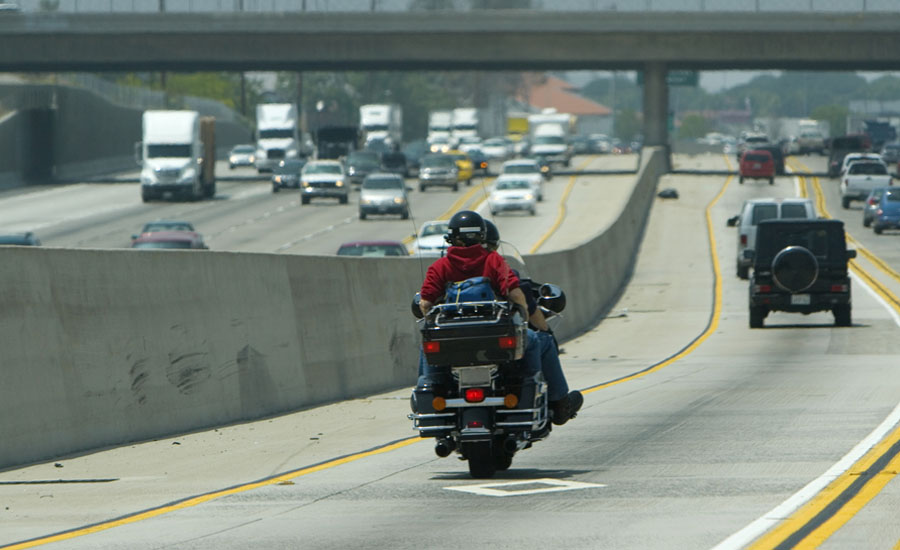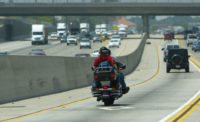A FairWarning story
Gridlock on anti-lock brakes baffles motorcycle safety advocates

After a long downward trend, U.S. traffic deaths are on the rise again, and a key factor is the stubbornly high fatality toll among some of the most exposed people on the road: motorcyclists.
Nevertheless, federal regulators have balked at requiring a safety measure that, many experts say, could save hundreds of bikers’ lives every year.
Anti-lock brake systems, a standard feature on lots of passenger vehicles since the 1990s, have been touted for years as a potentially powerful tool to cut motorcycle deaths. The technology, known as ABS, works by preventing the wheels from locking up during hard braking and improving control amid emergencies or slippery road conditions.
In the U.S., major law enforcement agencies, including the California Highway Patrol and the New York City Police Department, require that all motorcycles in their fleets have ABS. Around the world, ABS-equipped motorcycles are fast becoming standard. All new large bikes sold in Europe must now have ABS. On a phased-in schedule, Japan, India and Brazil are following suit.
“It is hard to come up with something else that has the potential to be as important for motorcycle safety,” said Adrian Lund, president of the Insurance Institute for Highway Safety, which estimates that nearly one-third of all fatal crashes from motorcycling every year, and many injuries, could be prevented by a federal ABS mandate.
Federal regulators at the National Highway Traffic Safety Administration, the officials who would be in a position to do something, have been criticized for taking an ambiguous, even mysterious stance. NHTSA has been something of an ABS cheerleader — praising it as a life-saver in the case of BMW Group, a leader in offering the technology — even though the safety agency fails to require it as a standard safety feature.
In 2009, the agency appeared close to mandating ABS on motorcycles. But within a couple of years, it shifted gears and shelved the proposal. The bottom line was that officials decided that there was insufficient proof that the benefits, measured by lives saved and injuries avoided, would outweigh costs to manufacturers.
And given that NHTSA lacked the political clout and scientific muscle to require ABS during the Obama administration, there appears to be practically no chance it will happen under the regulation-averse Trump administration, even with the annual death toll among motorcyclists hovering at close to 5,000. In a statement to FairWarning, the agency said its latest study on the issue, conducted in 2010, “did not demonstrate clear evidence to support regulatory activity and the agency currently does not have plans to pursue a new federal mandate to require ABS.”
NHTSA typically is slow to take action, when it acts at all. As FairWarning has reported, since at least 2011 NHTSA has been considering a crackdown on the sale of novelty motorcycle helmets that are nearly worthless in a crash. In May 2015, it finally took a preliminary step, issuing a notice of proposed rulemaking, but after nearly two years, the agency still has not issued a rule.
In the absence of action on ABS, motorcycle manufacturers gradually have been making the technology available. BMW Group introduced the first motorcycle with ABS in 1988, and made them standard equipment on all of the bikes it sells in the U.S. in 2012. According to the Insurance Institute, BMW remains the only major manufacturer to do so in the U.S.
Harley-Davidson, the nation’s largest manufacturer with about half of all domestic sales, began offering ABS on police department motorcycles in 2005, and then as optional equipment on some civilian bikes starting in 2008. By 2014, according to a court filing, Harley offered ABS as optional or standard on all of its models. The company declined comment for this story.
Yet even though sales of ABS-equipped motorcycles are increasing, they still accounted for no more than about 15 percent of the more than 7 million motorcycles registered in the U.S. in 2015, according to figures from Exponent Inc. The Menlo Park, Calif., consulting firm provided the data for Harley in connection with a lawsuit the motorcycle company was defending.
Much of the opposition to ABS has come from rider groups. The American Motorcyclist Association, for example, calls ABS “a powerful safety feature” but says riders should be free to choose whether their bikes have it. The group also opposes laws requiring motorcyclists to wear helmets, even though they have been proven to save lives and reduce health care costs.
Harley’s business approach has enabled it to sell ABS as an expensive safety option, while not offending the libertarian sensibilities of rider groups, including concerns that ABS components might clutter up the classic Harley look. At the same time, Harley has long acknowledged ABS safety benefits.
“So which Harley has ABS? Can’t tell? That’s intentional,” the company said in a video promoting its new line of ABS bikes in 2008. “They look nearly identical in going down the road,” said a voiceover. “But while they may look the same, there is definitely a difference during an emergency braking event.”
Nelson Roach, a Daingerfield, Texas, plaintiffs lawyer who brought an unsuccessful lawsuit against Harley related to its failure to use ABS throughout its product lines, likens the company’s approach to the way auto makers once resisted seat belt requirements. “In the 1970s, carmakers fought mandatory seat belts for two reasons. They wanted to continue selling them as a luxury option, and they were afraid a mandate would discourage people from buying cars,” he said.
For the last decade, Harley has “been doing the same thing with anti-lock brakes,” said Roach, who accuses NHTSA of kowtowing to the motorcycle industry.
Roach represented a Pittsburg, Texas, couple, who filed suit against Harley in federal court after a wreck in 2013 that they said would not have happened if their Harley had ABS. The husband had slammed on the brakes of his Harley to avoid a Chevy Avalanche pickup that had turned in his path. His wife was thrown from the bike and hit the pavement. Each suffered broken bones and brain injuries; their medical bills totaled more than $750,000.
Attorneys for Harley blamed the crash on the couple’s negligence, and noted that neither the husband nor the wife were wearing helmets. In January, the jury sided with Harley.
Even when Harley offers ABS, it has run into trouble. NHTSA announced last summer it was opening a preliminary investigation into reports of sudden ABS brake system failures on Harley models. Up to 430,000 ABS-equipped motorcycles for model years 2008-2011 are potentially affected. Harley has said it believes the problem lies with riders not servicing brake fluids regularly.
A bright spot for ABS advocates have been police departments around the country that have insisted for years on buying bikes equipped with the technology. For instance, both the California Highway Patrol and the Los Angeles Police Department have fleets of more than 400 ABS-equipped motorcycles.
“We see that as an important safety feature and want to provide our officers with the safest possible equipment,” said Steven Mills, head of the California Highway Patrol fleet operations section.
Likewise, all motorcycles purchased by the NYPD since 2006 – 130 Harley-Davidson Road Kings — have ABS.
Looking for a reprint of this article?
From high-res PDFs to custom plaques, order your copy today!
 Paul Feldman is a staff writer for FairWarning. Paul worked as a staff writer and editor at the Los Angeles Times for more than 30 years. He was a reporter on the Metro staff, and later a Metro desk editor, overseeing coverage of the environment, legal affairs and other topics. From 2003 through 2015, he served as an assistant foreign editor, working with a team of foreign correspondents on breaking news and features. He was a member of Metro teams that won two Pulitzer Prizes and two American Bar Assn. Silver Gavel awards. He also won the gold medal in a ping pong tournament on a Royal Caribbean cruise to Alaska.
Paul Feldman is a staff writer for FairWarning. Paul worked as a staff writer and editor at the Los Angeles Times for more than 30 years. He was a reporter on the Metro staff, and later a Metro desk editor, overseeing coverage of the environment, legal affairs and other topics. From 2003 through 2015, he served as an assistant foreign editor, working with a team of foreign correspondents on breaking news and features. He was a member of Metro teams that won two Pulitzer Prizes and two American Bar Assn. Silver Gavel awards. He also won the gold medal in a ping pong tournament on a Royal Caribbean cruise to Alaska. 




